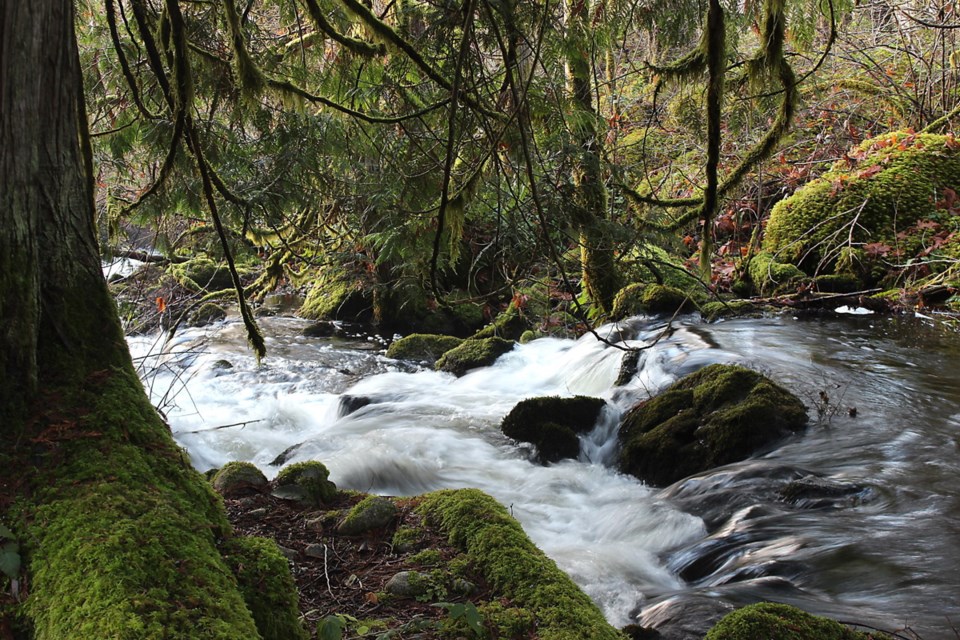When the property surrounding Mary Lake came on the market several years ago, Bob McMinn realized its value to Greater Victoria was priceless and worth protecting.
That was the beginning of the effort by the Greater Victoria Greenbelt Society to acquire and preserve the property, now called the Mary Lake Nature Sanctuary, for the benefit of future generations and environmental integrity.
The 30-hectare property off Millstream Road in west Highlands includes a three-hectare lake, several streams, wetlands and Douglas fir forest. It was owned from 1947 to 1963 by Victoria artist Gertrude Snider, who initiated conservation efforts on the land. Those efforts were continued by Peter and Hazel Brotherston when they brought the property in 1963.
“So, it has had 70 years of conservation,” said McMinn, 93. The chairman of the greenbelt society and founding mayor of the District of Highlands, he has been a champion of conservation in the area since moving there in 1953.
Society vice-chair Koi Neah said the society considered the potential for the land and decided to continue the focus on conservation. For most of the past century, nature has been in charge, and biologists consider it to be a pristine environment.
Neah said conservationists have been quick to recognize the value of the sanctuary, which lies within the coastal Douglas fir biogeoclimatic zone, home to the highest numbers of species and ecosystems at risk in B.C.
The Habitat Acquisition Trust, one of the supportive partners of the project, has been sending biologists to do species-at-risk assessments, as the ecosystems on the property have great preservation potential. The focus of the biologists is to identify important habitats and survey needs for focal species, which include the western painted turtle and blue-grey taildropper slug, both listed as endangered under the Species at Risk Act, as well as owls, amphibians and bats.
Several streams of the Millstream watershed flow through the sanctuary into the lake, resulting in more than 80 per cent of the land being classified as riparian (wetlands). Waterfowl such as mergansers, buffleheads and ring-necked ducks use the lake as a seasonal stopover.
Humans have not been left out of the equation.
The Mary Lake Nature Sanctuary is a definitely a place for people, Neah said, but on nature’s terms. Rather than people changing the environment, she said, the goal is to let the environment change people.
“People come here and say: “Ah, it’s so peaceful,’ ” Neah said. “They can’t believe there’s a place like this so close to the city.”
The 4,600-square-foot house on the edge of the lake is being transformed into the Highlands Nature House. It will be available for retreats, workshops and classes that fit with the vision of nature connection, conservation and education. Rentals will create an additional revenue source essential for sustaining the project.
In the coming year, the Bateman Centre will be offering children, youth and adult nature-sketching experiences, said Neah. Programs that encourage respect for the natural world are also being developed with a unique focus on forest and nature therapy, “an excellent experience for people of all ages who will benefit from its calming and rejuvenating influence,” she said.
The paved drive leading from Millstream Road to the nature house makes the sanctuary easily accessible to people with mobility problems, said McMinn.
While the sanctuary lies within the boundaries of the District of Highlands, it is a regional asset, said McMinn. The Capital Regional District has committed $500,000 for a corridor to be used for a trail connector that will link Gowlland Todd Provincial Park with Thetis Lake and Mount Work regional parks.
Neah said acquisition of the property by the greenbelt society means the site will be spared from encroaching development.
“For me, this work is motivated by the Joni Mitchell line: ‘We don’t know what we got till it’s gone. They paved paradise and put up a parking lot,’ ” she said.
The fall fundraising effort for the Mary Lake Nature Sanctuary is underway, and has been given a boost by a person who has promised to match donations over $25 made between now and the end of the year, up to a total matching gift of $25,000.
Donations can be made online at marylakeconnections.ca. They can also be sent to the Greater Victoria Greenbelt Society, 499 Millstream Lake Rd., Victoria, V9B 6H5.
The sanctuary trails are open to the public on the second Sunday of the month from 1 p.m. to 4 p.m. with a $5 donation. A visit can include a guided walk from 2 p.m. to 3 p.m., and a slideshow from 3 p.m. to 4 p.m. in the Highlands Nature House onsite. Appointments for groups can be arranged at other times. Contact info@marylakegvgs.com for inquiries.
Retired Times Colonist editorial writer David Bly is a director with the Greater Victoria Greenbelt Society.
